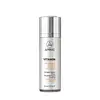What's inside
What's inside
 Key Ingredients
Key Ingredients

 Benefits
Benefits

 Ingredients Side-by-side
Ingredients Side-by-side

Water
Skin ConditioningPropanediol
SolventAscorbyl Glucoside
AntioxidantMaranta Arundinacea Root Extract
SmoothingMagnesium Ascorbyl Phosphate
AntioxidantCaprylic/Capric Triglyceride
MaskingSodium Citrate
BufferingSorbitan Olivate
EmulsifyingCetearyl Olivate
Oryzanol
Skin ConditioningKojic Dipalmitate
EmollientButylene Glycol
HumectantCetyl Palmitate
EmollientSorbitan Palmitate
EmulsifyingSodium Hydroxide
BufferingSclerotium Gum
Emulsion StabilisingAcacia Senegal Gum
MaskingCaprylyl Glyceryl Ether
CleansingXanthan Gum
EmulsifyingHydroxyacetophenone
AntioxidantTocopheryl Acetate
AntioxidantCitric Acid
BufferingCaprylhydroxamic Acid
Sclerocarya Birrea Seed Oil
HumectantBisabolol
MaskingHydrolyzed Rice Extract
Skin ConditioningGlycolipids
Skin ConditioningWater, Propanediol, Ascorbyl Glucoside, Maranta Arundinacea Root Extract, Magnesium Ascorbyl Phosphate, Caprylic/Capric Triglyceride, Sodium Citrate, Sorbitan Olivate, Cetearyl Olivate, Oryzanol, Kojic Dipalmitate, Butylene Glycol, Cetyl Palmitate, Sorbitan Palmitate, Sodium Hydroxide, Sclerotium Gum, Acacia Senegal Gum, Caprylyl Glyceryl Ether, Xanthan Gum, Hydroxyacetophenone, Tocopheryl Acetate, Citric Acid, Caprylhydroxamic Acid, Sclerocarya Birrea Seed Oil, Bisabolol, Hydrolyzed Rice Extract, Glycolipids
 Reviews
Reviews

Ingredients Explained
These ingredients are found in both products.
Ingredients higher up in an ingredient list are typically present in a larger amount.
Acacia Senegal Gum has skin soothing, thickening, and formulation stabilizing properties. It comes from the Acacia tree that is native to sub-Saharan Africa.
Ascorbyl Glucoside is a stable form of Vitamin C. It is created by combining glucose from starch.
When applied to skin, Ascorbyl Glucoside turns into Ascorbic Acid.
Ascorbyl Glucoside is an antioxidant. Antioxidants help fight free-radicals, or molecules that may damage skin cells.
It can help to reduce redness, improve skin texture, reduce the effects of aging, reduce the visibility of dark spots, and brighten skin.
Read more about other types of Vitamin C:
Learn more about Ascorbyl GlucosideSodium Hydroxide is also known as lye or caustic soda. It is used to adjust the pH of products; many ingredients require a specific pH to be effective.
In small amounts, sodium hydroxide is considered safe to use. However, large amounts may cause chemical burns due to its high alkaline.
Your skin has a natural pH and acid mantle. This acid mantle helps prevent harmful bacteria from breaking through. The acid mantle also helps keep your skin hydrated.
"Alkaline" refers to a high pH level. A low pH level would be considered acidic.
Learn more about Sodium HydroxideTocopheryl Acetate is AKA Vitamin E. It is an antioxidant and protects your skin from free radicals. Free radicals damage the skin by breaking down collagen.
One study found using Tocopheryl Acetate with Vitamin C decreased the number of sunburned cells.
Tocopheryl Acetate is commonly found in both skincare and dietary supplements.
Learn more about Tocopheryl AcetateWater. It's the most common cosmetic ingredient of all. You'll usually see it at the top of ingredient lists, meaning that it makes up the largest part of the product.
So why is it so popular? Water most often acts as a solvent - this means that it helps dissolve other ingredients into the formulation.
You'll also recognize water as that liquid we all need to stay alive. If you see this, drink a glass of water. Stay hydrated!
Learn more about WaterXanthan gum is used as a stabilizer and thickener within cosmetic products. It helps give products a sticky, thick feeling - preventing them from being too runny.
On the technical side of things, xanthan gum is a polysaccharide - a combination consisting of multiple sugar molecules bonded together.
Xanthan gum is a pretty common and great ingredient. It is a natural, non-toxic, non-irritating ingredient that is also commonly used in food products.
Learn more about Xanthan Gum